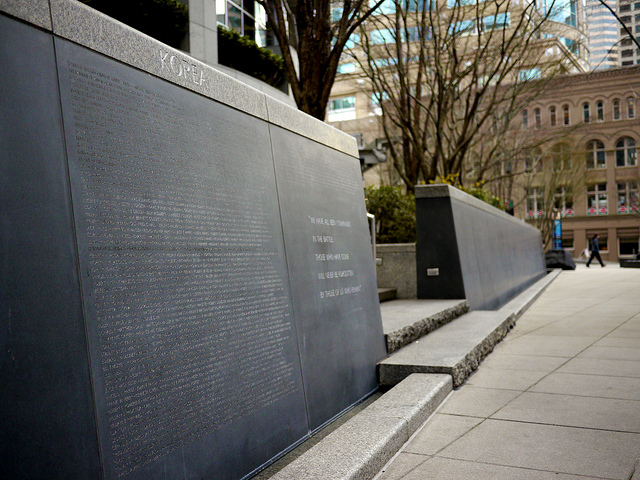One man stood out from the rest. I looked up about 100 men who died in the Korean War, all supposedly from Seattle or King County, Washington. The rest had sensible stories or cold trails. But Lloyd Spencer Sullivan begged closer inspection. He died in a forgotten war, with misleading information in the casualty database.
What was wrong
Let’s get the half-truths out of the way. Here is a link to his detailed database entry. I’m going to question his race and his home.
The military file says that he was Caucasian. In fact, he was half-Irish, half-Eskimo. So it’s half-right. In the 1940 census his father James Sullivan is listed as white, born in the “Irish Free State“. EIRE is written oddly between the lines, the Irish name for Ireland. James’ wife Mary and all ten children are categorized as “Esk” for Eskimo, with linguistic stock of “Ath” which I assume is Athabaskan. Oddly, the National Archives’ key for the 1940 census makes no mention of the Esk category, and has no key for linguistic stock.
The second imperfection is that he does not appear to have ties to Seattle. He grew up in Alaska. On his Report of Interment the state field has Alaska typed in, with “Born” written in pencil above and “Enl[isted] Wash[ington]” in parentheses next to it. The 1940 census has him in Skagway, and he is one of eight men remembered on Skagway’s memorial to fallen soldiers. The Seattle Times wasn’t aware of his Seattle connection or they would have mentioned his 1951 death in Korea.
Other oddities
Lloyd’s Report of Interment has two other things that are confusing. He is buried in San Diego. What was his connection to California?
Also his wife was living in Blackfoot, Idaho at the time of his burial. Why was his wife in Idaho? He was 18 when he enlisted, he barely even had time to get married. Who was she? Her name is just “Mrs. Lloyd Sullivan (widow)”.
Facts about Lloyd
Here are the accounts of Lloyd’s service and death that I have found. Lloyd survived the hellacious Battle for the Punchbowl but died in the early days of October 1951 in its aftermath. He was one of 17 soldiers from 1st Marine Division killed in the first two weeks of that month. He and another man died on October 4th. On that day, 71 enemies were confirmed dead with estimated 262 killed by the 1st Marines.
Service Info.: PFC US MARINE CORPS
Birth Date: 14 Feb 1932
Death Date: 4 Oct 1951
Service Start Date: 1 Sep 1950
Interment Date: 18 Jan 1952
“Private First Class Sullivan was a member of Headquarters Company, 1st Engineer Battalion, 1st Marine Division. He was Killed in Action while fighting the enemy in Korea on October 4, 1951. Private First Class Sullivan was awarded the Purple Heart, the Combat Action Ribbon, the Korean Service Medal, the United Nations Service Medal, the National Defense Service Medal, the Korean Presidential Unit Citation and the Republic of Korea War Service Medal.”
Casualty Type: Hostile – Killed
Casualty Cause: Explosive Device (Grenade, Mine, Booby Trap, etc.)
Casualty Air: Ground Casualty
I expected to find some mention in the 1st Marine Division Historical Diary for October 1951, but I don’t see anything. Maybe I’m not good enough at reading the communication shorthand yet.
I’m no closer to knowing what kind of person he was, and the peculiarity of the facts leaves the story feeling unresolved. But perhaps the next time you walk past the memorial at Second and University, you’ll pause to see Lloyd Sullivan’s name. I hope he will remind you of the imperfection of data and the complexity and fragility of life.
I have to say that I lied in my opening sentence. Each of the 100 stories had its own beauty. There are others like Lloyd’s that have grabbed hold of me. They are so laced with tragedy and pain, though, that I don’t plan to try and pursue any more. Lloyd is enough.
Further reading
- Seattle’s second Seafair, photos of a troop transport arriving back home
- Mapping Seattle and the Forgotten War, in which I find the homes of each Korean War KIA in Seattle
- Seattle’s first Korean War parade, describing the return of veterans
- Waning days of One woman’s war, about a woman who served in Seattle during World War Two
- Wolf Cubs lost at war, part of a series about the beginning of Cub Scouts and telling the stories of a group that died in World War Two
- (Witness weeps) – the tragedy of Alvin Monson, part of a series about early grocery history telling of a shell shocked businessman in World War One
Discover more from ba-kground
Subscribe to get the latest posts sent to your email.



Thank you for this. My uncle Lloyd was a vibrant, postive person and I am just learning more about his life. My fater Mike (youngest of 11) could help with information.